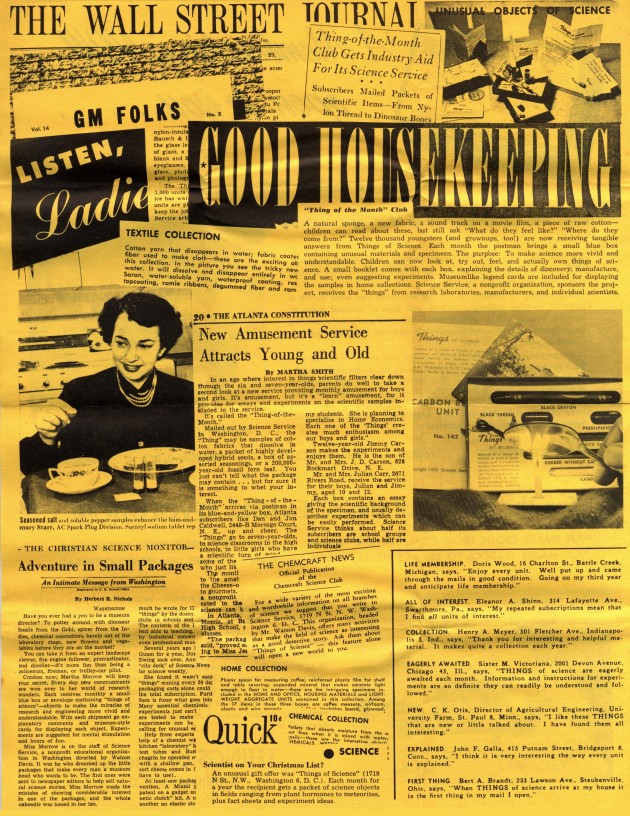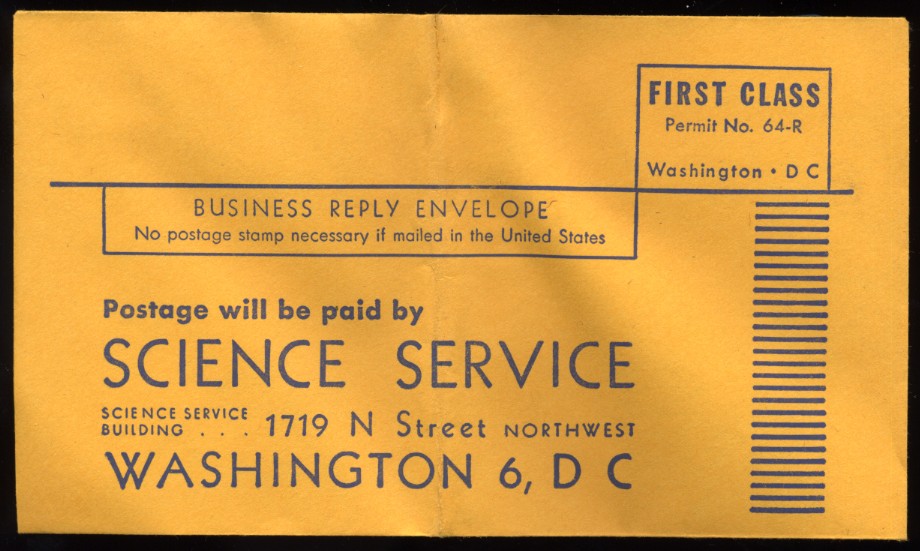

The flyer, postcard, and reply envelope shown below were included in unit 195 (The Mollusk, January 1957). Although the flyer itself is undated, the clippings reproduced on its back suggest that it may have been produced as early as 1952. Units mentioned on the front side were issued as late as November 1954 (Pharmacology), although these might represent titles that were planned but not yet issued at the time the flyer was composed. An earlier version of this flyer may have accompanied the Sea Shell Unit of July 1951.
Since the Things of Science program was operated without profit and with donated materials (subscription fees paid for postage and little more), it was necessary to limit membership. In 1952 (and probably for several years before and after), the program had 12,000 subscribers; the flyer announced that arrangements had been made "for increased production to accommodate a limited number of new members," an important milestone in the program's history.
Click on the images to view high-resolution versions.
The clipping in the lower left corner of the back of the flyer ("Adventure in Small Packages") is of an article that appeared in the Christian Science Monitor of June 2, 1952, on page 26. Its author, Herbert B. Nichols, was the natural science editor of the Monitor at the time. The remainder of the article (which may be read in its entirety here) includes a bit of background about the production of a Things of Science kit (almost certainly the Seasoning Unit, number 124, February, 1951, which contains all of the seasonings mentioned):
[Martha Morrow's] work has won her friends all over the world. Children, teachers, and grandparents write their appreciation. Sometimes they send something from their own desk or table-top museum -- a bit of radioactive fused glass from the first A-bomb experiment, a chunk of quartz with tiny flecks of gold, a new plastic, a stalactite from Carlsbad, unusual seashells, petrified wood, seeds from a newly developed flower. But a note of warning to all generous people. A letter may come by return mail saying, "Can you let me have 12,000 more?"That happened one day to an importer of spices, herbs, and seeds. How fragrant his new shipment of cloves from Madagascar; how fascinating his raw ginger root and cinnamon bark; how delightful to sink both arms elbow deep in a bin of poppy seed from the Netherlands!
"Could he package a tiny bit of each, and some Turkish bay leaves, cardamom seed from India, maybe a nutmeg, in 12,000 little boxes for her to give to friends?"
It took some dickering but he agreed. There was a whimsical barb to his "yes," however. "Gosh, lady," he said, "I'd sure hate to take you into Tiffany's!"
GM Folks was a monthly magazine produced by General Motors for its employees between 1938 and 1956. The photo of Ms. Starr of the AC Spark Plug Division enjoying seasoned salt and soluble pepper (probably from unit 116, Taste Enhancers, June, 1950) is apparently from the issue of March 1952 (vol. 14, no. 3).
Chemcraft News, "the Official Publication of the Chemcraft Science Club," was an occasional publication from the Porter Chemical Company of Hagerstown, Maryland, makers of Chemcraft chemistry sets. The date of the clipping is unknown.
Several other clippings visible on the flyer ("Textile Collection," "Home Collection," and "Chemical Collection") appear to come from the Science Service's catalog; the units mentioned are from the late 1940s. The photo at upper right ("Unusual Objects of Science") shows the Glass Lens Unit (62, December 1945) and two other units that are difficult to identify, but may include the Tricky Minerals Unit (61, November 1945) and the Coal Unit (52, February 1945). The photo at center right shows the Carbon Black Unit (142, August 1952).
The article from the Wall Street Journal appeared on page 1 of the issue of August 29, 1946. It was written by then staff correspondent Jonas Robitscher (1920-1981), who later became well-known as a pioneer of forensic psychiatry. Robitscher interviewed Watson Davis for the article, which contains a good deal of information about the early history and production of Things of Science (for example, noting that units were planned six months in advance in Washington, and packed and mailed from New York). Of the topics, he wrote:
Mr. Davis explains that the units usually fall into one of four categories. The petroleum unit [no. 64, February 1946] was a "process story," for instance. Subscribers received samples of crude oil, sour crude oil, heavy black crude oil, formation water (left by the ancient seas and "among the oldest water in the world," according to Mr. Davis), cuttings (bits of material dug out in drilling an oil well), and samples of the type of earth in oil-bearing regions.
A "new products story" unit might contain plastic coated yarn, detergents (cleansing agents), or transparent packaging [unit 15, January 1942].
Next there is the "news story" unit. The samples of the Paracutin lava [unit 49, November 1944] -- brought from the volcano site to the nearest railhead by burro-back -- and a recent bread-grain unit -- [no. 66, April 1946] inspired by the world grain shortage are examples of this type.
A fourth type of unit is the "standard museum specimen unit." One of these contained specimens with a combined age of well over half a billion years -- a piece of a dinosaur's bone, some lignitized wood, a fossil brachiopod (small shellfish). [unit 8, June 1941]
The other clippings, from the Atlanta Constitution, Good Housekeeping, and Quick News Weekly (c. 1949-1953), have not yet been identified or dated. Interestingly, three of these articles, including Robitscher's, refer to Things of Science as the Thing-of-the-Month Club, but this name does not seem to have been used by the Science Service itself.
If you locate further information about any of these clippings (or about other press articles relating to the Things of Science program), please send the details to me (george at mit dot edu).

